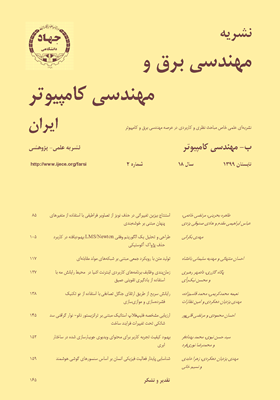استنتاج بیزین تغییراتی در حذف نویز از تصاویر فراطیفی با استفاده از متغیرهای پنهان مبتنی بر خوشهبندی
محورهای موضوعی : مهندسی برق و کامپیوترطاهره بحرینی 1 , عباس ابراهیمی مقدم 2 , مرتضی خادمی 3 , هادی صدوقی یزدی 4
1 - دانشگاه فردوسی مشهد
2 - دانشگاه فردوسی مشهد
3 - دانشگاه فردوسی مشهد
4 - دانشگاه فردوسی مشهد
کلید واژه: حذف نویز تصویرمتغیر پنهانتصاویر فراطیفیتجزیه ماتریس مرتبه پاییناستنتاج بیزین تغییراتینویز ترکیبی,
چکیده مقاله :
حذف نویز از تصاویر فراطیفی گامی اجتنابناپذیر برای بهبود کیفیت این نوع تصاویر است و روشهای بسیاری در این زمینه توسط محققان پیشنهاد شده است. اغلب این روشها به شباهتهای مکانی- طیفی به طور همزمان توجه ندارند. زمانی که روش حذف نویز، داده را به صورت سراسری بدون در نظر گرفتن شباهتهای مکانی- طیفی به کار میبرد، معمولاً بر روی پیکسلهای با سطح پایین نویز تأثیر نامطلوب میگذارد؛ آن هم زمانی که در داده فراطیفی، تعداد زیادی از پیکسلها نویز کمی دارند و تعداد اندکی از پیکسلها به وسیله سطح بالای نویز تخریب میشوند. در این مقاله، ابتدا شباهتهای مکانی- طیفی موجود در تصاویر با تعریف متغیر پنهان مبتنی بر خوشهبندی استخراج میشود. در ادامه، یک روش تجزیه ماتریس رتبهپایین مبتنی بر این متغیرهای پنهان برای حذف نویز تصاویر فراطیفی و بهبود مقاومت در مقابل انواع نویز (در مقایسه با سایر روشها) پیشنهاد میشود. کارایی روش پیشنهادی با شش روش جدید بر روی تصاویر واقعی آلوده به نویز به صورت بصری مقایسه شده و برای مقایسه کمی، همان آزمایشها روی تصاویر بدون نویزی که با شش نوع نویز ترکیب شده و تصاویری نزدیک به داده واقعی ایجاد کردهاند مقایسه شده است. نتایج شبیهسازی نشان میدهد که با اعمال متغیر پنهان در چارچوب استنتاج بیزین تغییراتی، عملکرد روش حذف نویز بهبود مییابد و روش پیشنهادی عملکرد بهتری نسبت به سایر روشهای مورد مقایسه دارد.
Removing noise from hyperspectral images is an inevitable step to improve the quality of these types of images. Many methods have been proposed by researchers in this field. Most of these methods do not address simultaneous spatial-spectral similarities. When the noise removal method applies data globally without regard to spatial-spectral similarities, it usually has a negative effect on low-level pixels; when in the spectral data, a large number of pixels have little noise and a small number of pixels are destroyed by the high level of noise. In this paper, we first extract spatial-spectral similarities in images by defining cluster-based latent variables. In the following, a low-rank matrix factorization method based on these latent variables is proposed to eliminate the noise of hyperspectral images and to improve the resistance to noise (as compared to other methods). The performance of the proposed method is compared visually with six new methods on real noise-contaminated images. For quantitative comparison, the same experiments are done on clean images combined with six types of simulated noise. The simulation results show that by applying latent variables in the Bayesian inference framework, the performance of the noise removal method is improved and the proposed method performs better than the other methods.


